Financial Accounting Principles Report - Finance, University of ABC
VerifiedAdded on 2020/10/05
|27
|4402
|498
Report
AI Summary
This report delves into the core principles of financial accounting, encompassing the concepts, regulations, rules, and conventions that govern the field. It begins with an introduction to financial accounting, outlining its purpose and the various regulations associated with it, such as those from the IASB and IFRS. The report then explores key accounting rules, including personal, real, and nominal accounts, along with fundamental accounting principles like materiality, revenue recognition, and the going concern concept. It also examines conventions related to consistency and material disclosure, and the accrual concept. The report includes detailed examples and ledger accounts for multiple clients to illustrate these principles in practice, covering aspects like sales, purchases, and bank transactions. The preparation of profit and loss statements and concepts of bank reconciliation statements are also included, providing a comprehensive overview of financial accounting practices.
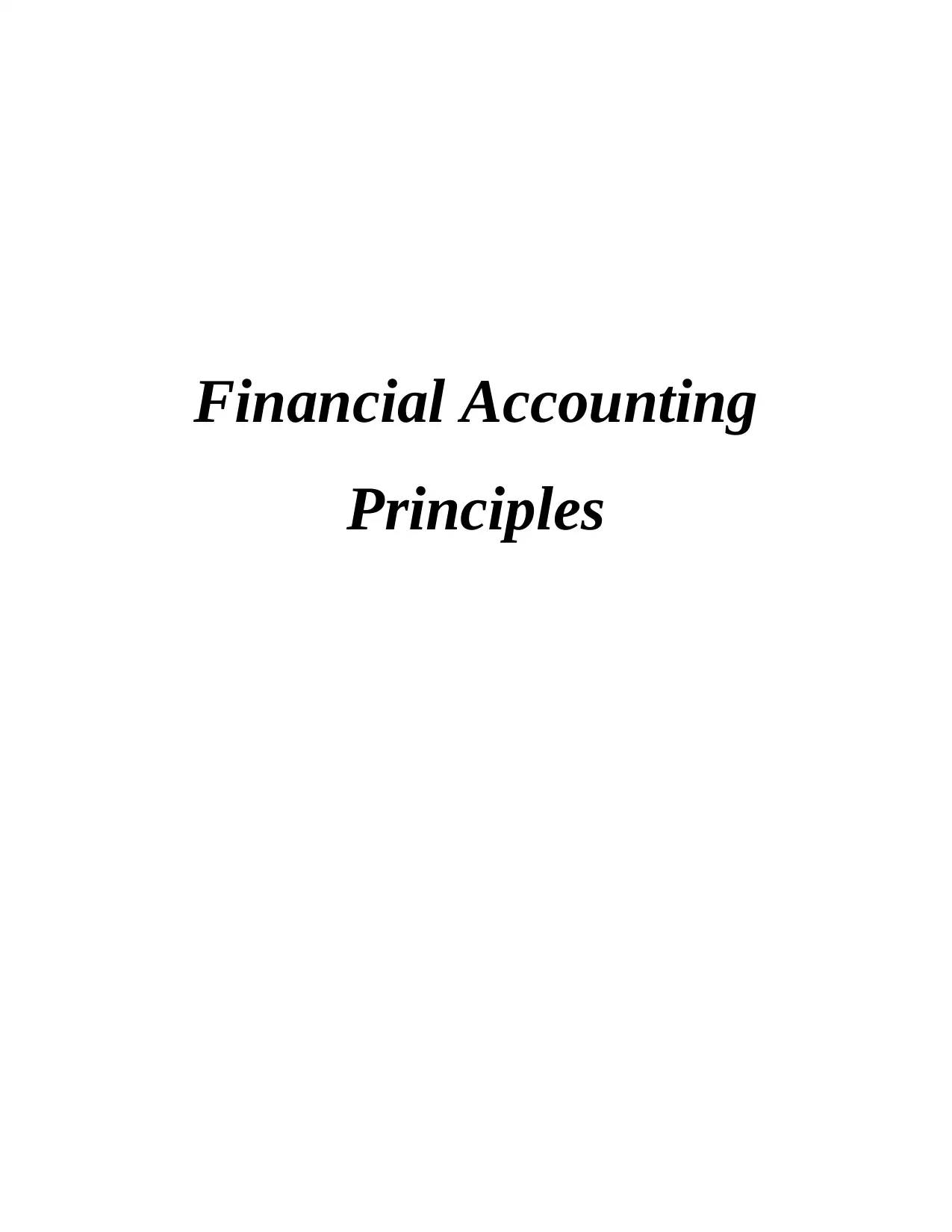
Financial Accounting
Principles
Principles
Paraphrase This Document
Need a fresh take? Get an instant paraphrase of this document with our AI Paraphraser
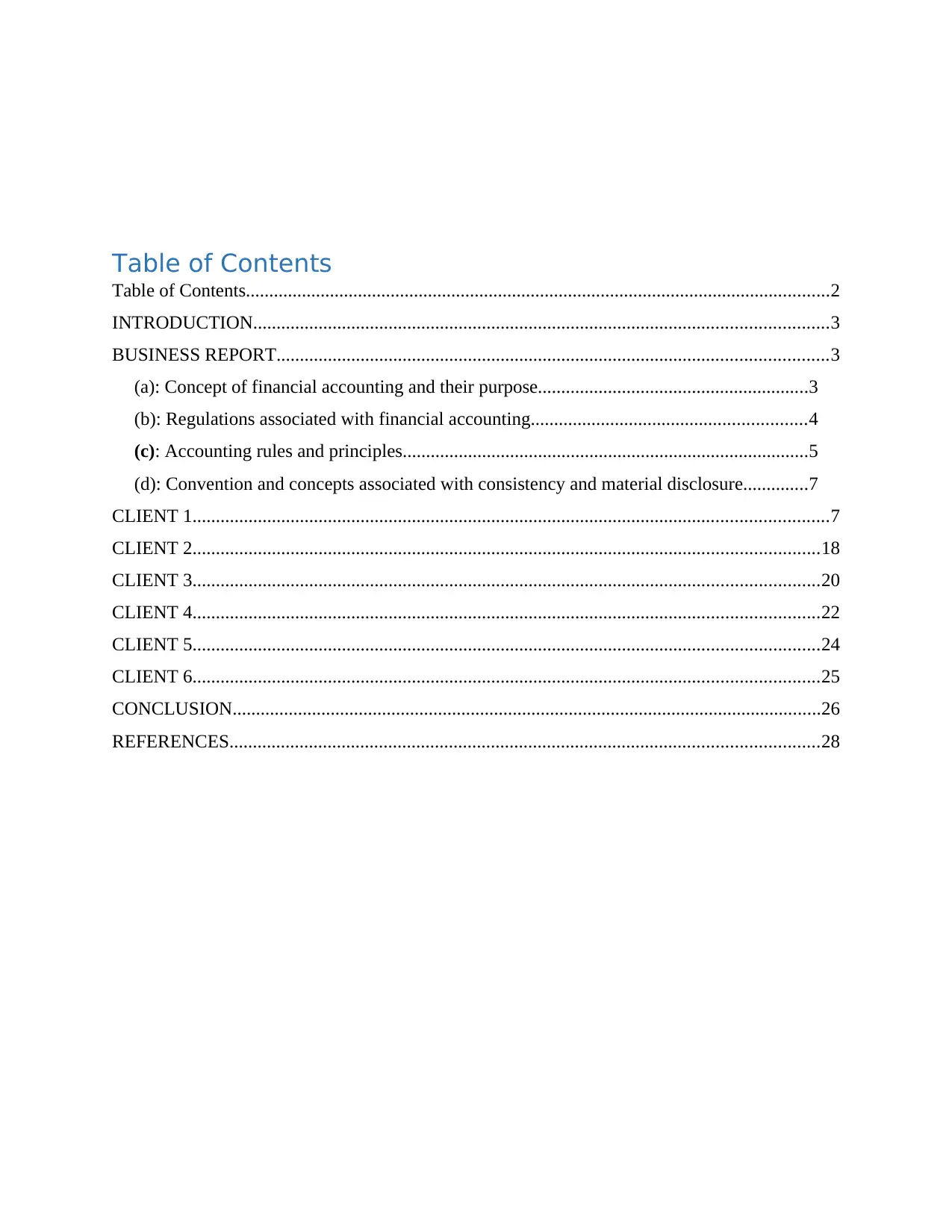
Table of Contents
Table of Contents.............................................................................................................................2
INTRODUCTION...........................................................................................................................3
BUSINESS REPORT......................................................................................................................3
(a): Concept of financial accounting and their purpose..........................................................3
(b): Regulations associated with financial accounting...........................................................4
(c): Accounting rules and principles.......................................................................................5
(d): Convention and concepts associated with consistency and material disclosure..............7
CLIENT 1........................................................................................................................................7
CLIENT 2......................................................................................................................................18
CLIENT 3......................................................................................................................................20
CLIENT 4......................................................................................................................................22
CLIENT 5......................................................................................................................................24
CLIENT 6......................................................................................................................................25
CONCLUSION..............................................................................................................................26
REFERENCES..............................................................................................................................28
Table of Contents.............................................................................................................................2
INTRODUCTION...........................................................................................................................3
BUSINESS REPORT......................................................................................................................3
(a): Concept of financial accounting and their purpose..........................................................3
(b): Regulations associated with financial accounting...........................................................4
(c): Accounting rules and principles.......................................................................................5
(d): Convention and concepts associated with consistency and material disclosure..............7
CLIENT 1........................................................................................................................................7
CLIENT 2......................................................................................................................................18
CLIENT 3......................................................................................................................................20
CLIENT 4......................................................................................................................................22
CLIENT 5......................................................................................................................................24
CLIENT 6......................................................................................................................................25
CONCLUSION..............................................................................................................................26
REFERENCES..............................................................................................................................28
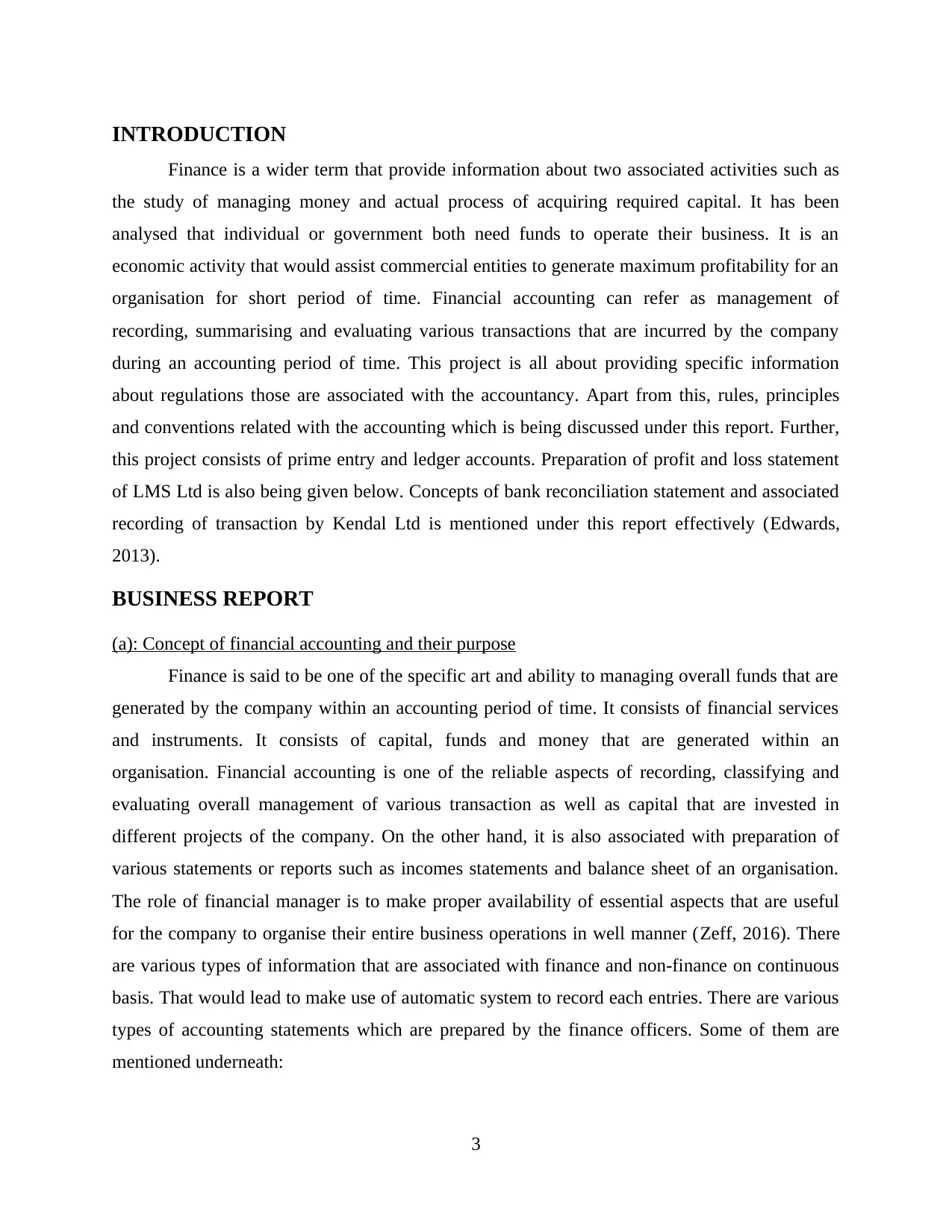
INTRODUCTION
Finance is a wider term that provide information about two associated activities such as
the study of managing money and actual process of acquiring required capital. It has been
analysed that individual or government both need funds to operate their business. It is an
economic activity that would assist commercial entities to generate maximum profitability for an
organisation for short period of time. Financial accounting can refer as management of
recording, summarising and evaluating various transactions that are incurred by the company
during an accounting period of time. This project is all about providing specific information
about regulations those are associated with the accountancy. Apart from this, rules, principles
and conventions related with the accounting which is being discussed under this report. Further,
this project consists of prime entry and ledger accounts. Preparation of profit and loss statement
of LMS Ltd is also being given below. Concepts of bank reconciliation statement and associated
recording of transaction by Kendal Ltd is mentioned under this report effectively (Edwards,
2013).
BUSINESS REPORT
(a): Concept of financial accounting and their purpose
Finance is said to be one of the specific art and ability to managing overall funds that are
generated by the company within an accounting period of time. It consists of financial services
and instruments. It consists of capital, funds and money that are generated within an
organisation. Financial accounting is one of the reliable aspects of recording, classifying and
evaluating overall management of various transaction as well as capital that are invested in
different projects of the company. On the other hand, it is also associated with preparation of
various statements or reports such as incomes statements and balance sheet of an organisation.
The role of financial manager is to make proper availability of essential aspects that are useful
for the company to organise their entire business operations in well manner (Zeff, 2016). There
are various types of information that are associated with finance and non-finance on continuous
basis. That would lead to make use of automatic system to record each entries. There are various
types of accounting statements which are prepared by the finance officers. Some of them are
mentioned underneath:
3
Finance is a wider term that provide information about two associated activities such as
the study of managing money and actual process of acquiring required capital. It has been
analysed that individual or government both need funds to operate their business. It is an
economic activity that would assist commercial entities to generate maximum profitability for an
organisation for short period of time. Financial accounting can refer as management of
recording, summarising and evaluating various transactions that are incurred by the company
during an accounting period of time. This project is all about providing specific information
about regulations those are associated with the accountancy. Apart from this, rules, principles
and conventions related with the accounting which is being discussed under this report. Further,
this project consists of prime entry and ledger accounts. Preparation of profit and loss statement
of LMS Ltd is also being given below. Concepts of bank reconciliation statement and associated
recording of transaction by Kendal Ltd is mentioned under this report effectively (Edwards,
2013).
BUSINESS REPORT
(a): Concept of financial accounting and their purpose
Finance is said to be one of the specific art and ability to managing overall funds that are
generated by the company within an accounting period of time. It consists of financial services
and instruments. It consists of capital, funds and money that are generated within an
organisation. Financial accounting is one of the reliable aspects of recording, classifying and
evaluating overall management of various transaction as well as capital that are invested in
different projects of the company. On the other hand, it is also associated with preparation of
various statements or reports such as incomes statements and balance sheet of an organisation.
The role of financial manager is to make proper availability of essential aspects that are useful
for the company to organise their entire business operations in well manner (Zeff, 2016). There
are various types of information that are associated with finance and non-finance on continuous
basis. That would lead to make use of automatic system to record each entries. There are various
types of accounting statements which are prepared by the finance officers. Some of them are
mentioned underneath:
3
⊘ This is a preview!⊘
Do you want full access?
Subscribe today to unlock all pages.

Trusted by 1+ million students worldwide
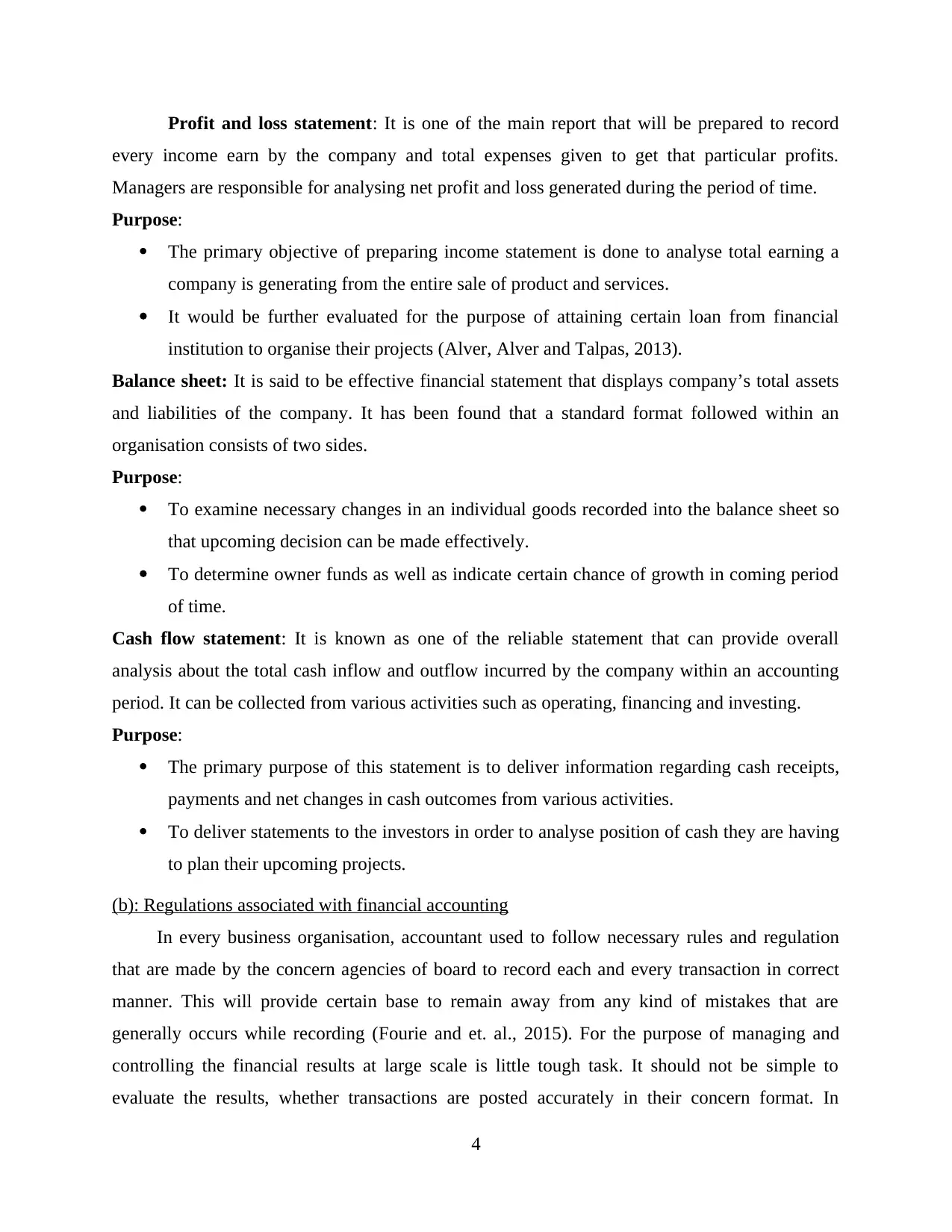
Profit and loss statement: It is one of the main report that will be prepared to record
every income earn by the company and total expenses given to get that particular profits.
Managers are responsible for analysing net profit and loss generated during the period of time.
Purpose:
The primary objective of preparing income statement is done to analyse total earning a
company is generating from the entire sale of product and services.
It would be further evaluated for the purpose of attaining certain loan from financial
institution to organise their projects (Alver, Alver and Talpas, 2013).
Balance sheet: It is said to be effective financial statement that displays company’s total assets
and liabilities of the company. It has been found that a standard format followed within an
organisation consists of two sides.
Purpose:
To examine necessary changes in an individual goods recorded into the balance sheet so
that upcoming decision can be made effectively.
To determine owner funds as well as indicate certain chance of growth in coming period
of time.
Cash flow statement: It is known as one of the reliable statement that can provide overall
analysis about the total cash inflow and outflow incurred by the company within an accounting
period. It can be collected from various activities such as operating, financing and investing.
Purpose:
The primary purpose of this statement is to deliver information regarding cash receipts,
payments and net changes in cash outcomes from various activities.
To deliver statements to the investors in order to analyse position of cash they are having
to plan their upcoming projects.
(b): Regulations associated with financial accounting
In every business organisation, accountant used to follow necessary rules and regulation
that are made by the concern agencies of board to record each and every transaction in correct
manner. This will provide certain base to remain away from any kind of mistakes that are
generally occurs while recording (Fourie and et. al., 2015). For the purpose of managing and
controlling the financial results at large scale is little tough task. It should not be simple to
evaluate the results, whether transactions are posted accurately in their concern format. In
4
every income earn by the company and total expenses given to get that particular profits.
Managers are responsible for analysing net profit and loss generated during the period of time.
Purpose:
The primary objective of preparing income statement is done to analyse total earning a
company is generating from the entire sale of product and services.
It would be further evaluated for the purpose of attaining certain loan from financial
institution to organise their projects (Alver, Alver and Talpas, 2013).
Balance sheet: It is said to be effective financial statement that displays company’s total assets
and liabilities of the company. It has been found that a standard format followed within an
organisation consists of two sides.
Purpose:
To examine necessary changes in an individual goods recorded into the balance sheet so
that upcoming decision can be made effectively.
To determine owner funds as well as indicate certain chance of growth in coming period
of time.
Cash flow statement: It is known as one of the reliable statement that can provide overall
analysis about the total cash inflow and outflow incurred by the company within an accounting
period. It can be collected from various activities such as operating, financing and investing.
Purpose:
The primary purpose of this statement is to deliver information regarding cash receipts,
payments and net changes in cash outcomes from various activities.
To deliver statements to the investors in order to analyse position of cash they are having
to plan their upcoming projects.
(b): Regulations associated with financial accounting
In every business organisation, accountant used to follow necessary rules and regulation
that are made by the concern agencies of board to record each and every transaction in correct
manner. This will provide certain base to remain away from any kind of mistakes that are
generally occurs while recording (Fourie and et. al., 2015). For the purpose of managing and
controlling the financial results at large scale is little tough task. It should not be simple to
evaluate the results, whether transactions are posted accurately in their concern format. In
4
Paraphrase This Document
Need a fresh take? Get an instant paraphrase of this document with our AI Paraphraser
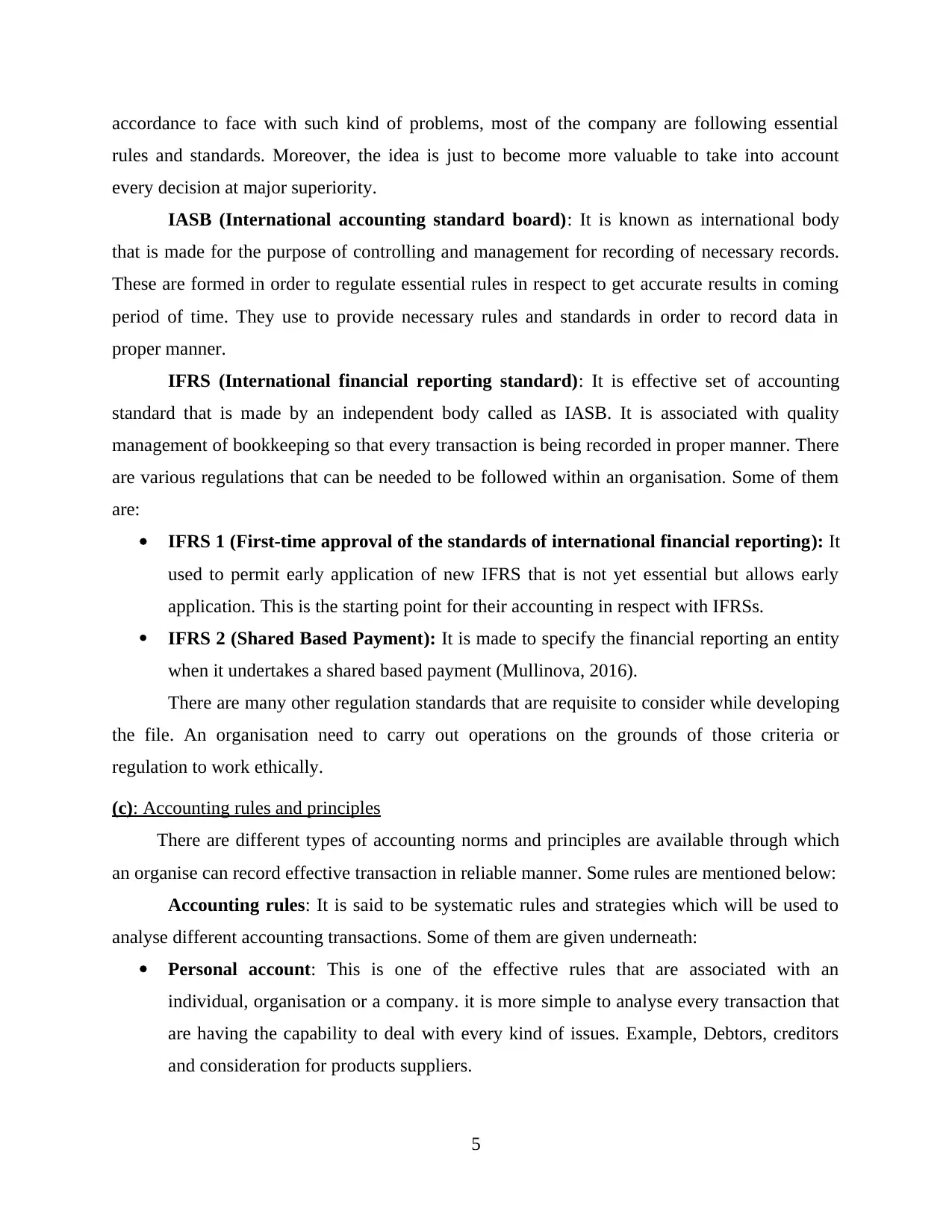
accordance to face with such kind of problems, most of the company are following essential
rules and standards. Moreover, the idea is just to become more valuable to take into account
every decision at major superiority.
IASB (International accounting standard board): It is known as international body
that is made for the purpose of controlling and management for recording of necessary records.
These are formed in order to regulate essential rules in respect to get accurate results in coming
period of time. They use to provide necessary rules and standards in order to record data in
proper manner.
IFRS (International financial reporting standard): It is effective set of accounting
standard that is made by an independent body called as IASB. It is associated with quality
management of bookkeeping so that every transaction is being recorded in proper manner. There
are various regulations that can be needed to be followed within an organisation. Some of them
are:
IFRS 1 (First-time approval of the standards of international financial reporting): It
used to permit early application of new IFRS that is not yet essential but allows early
application. This is the starting point for their accounting in respect with IFRSs.
IFRS 2 (Shared Based Payment): It is made to specify the financial reporting an entity
when it undertakes a shared based payment (Mullinova, 2016).
There are many other regulation standards that are requisite to consider while developing
the file. An organisation need to carry out operations on the grounds of those criteria or
regulation to work ethically.
(c): Accounting rules and principles
There are different types of accounting norms and principles are available through which
an organise can record effective transaction in reliable manner. Some rules are mentioned below:
Accounting rules: It is said to be systematic rules and strategies which will be used to
analyse different accounting transactions. Some of them are given underneath:
Personal account: This is one of the effective rules that are associated with an
individual, organisation or a company. it is more simple to analyse every transaction that
are having the capability to deal with every kind of issues. Example, Debtors, creditors
and consideration for products suppliers.
5
rules and standards. Moreover, the idea is just to become more valuable to take into account
every decision at major superiority.
IASB (International accounting standard board): It is known as international body
that is made for the purpose of controlling and management for recording of necessary records.
These are formed in order to regulate essential rules in respect to get accurate results in coming
period of time. They use to provide necessary rules and standards in order to record data in
proper manner.
IFRS (International financial reporting standard): It is effective set of accounting
standard that is made by an independent body called as IASB. It is associated with quality
management of bookkeeping so that every transaction is being recorded in proper manner. There
are various regulations that can be needed to be followed within an organisation. Some of them
are:
IFRS 1 (First-time approval of the standards of international financial reporting): It
used to permit early application of new IFRS that is not yet essential but allows early
application. This is the starting point for their accounting in respect with IFRSs.
IFRS 2 (Shared Based Payment): It is made to specify the financial reporting an entity
when it undertakes a shared based payment (Mullinova, 2016).
There are many other regulation standards that are requisite to consider while developing
the file. An organisation need to carry out operations on the grounds of those criteria or
regulation to work ethically.
(c): Accounting rules and principles
There are different types of accounting norms and principles are available through which
an organise can record effective transaction in reliable manner. Some rules are mentioned below:
Accounting rules: It is said to be systematic rules and strategies which will be used to
analyse different accounting transactions. Some of them are given underneath:
Personal account: This is one of the effective rules that are associated with an
individual, organisation or a company. it is more simple to analyse every transaction that
are having the capability to deal with every kind of issues. Example, Debtors, creditors
and consideration for products suppliers.
5
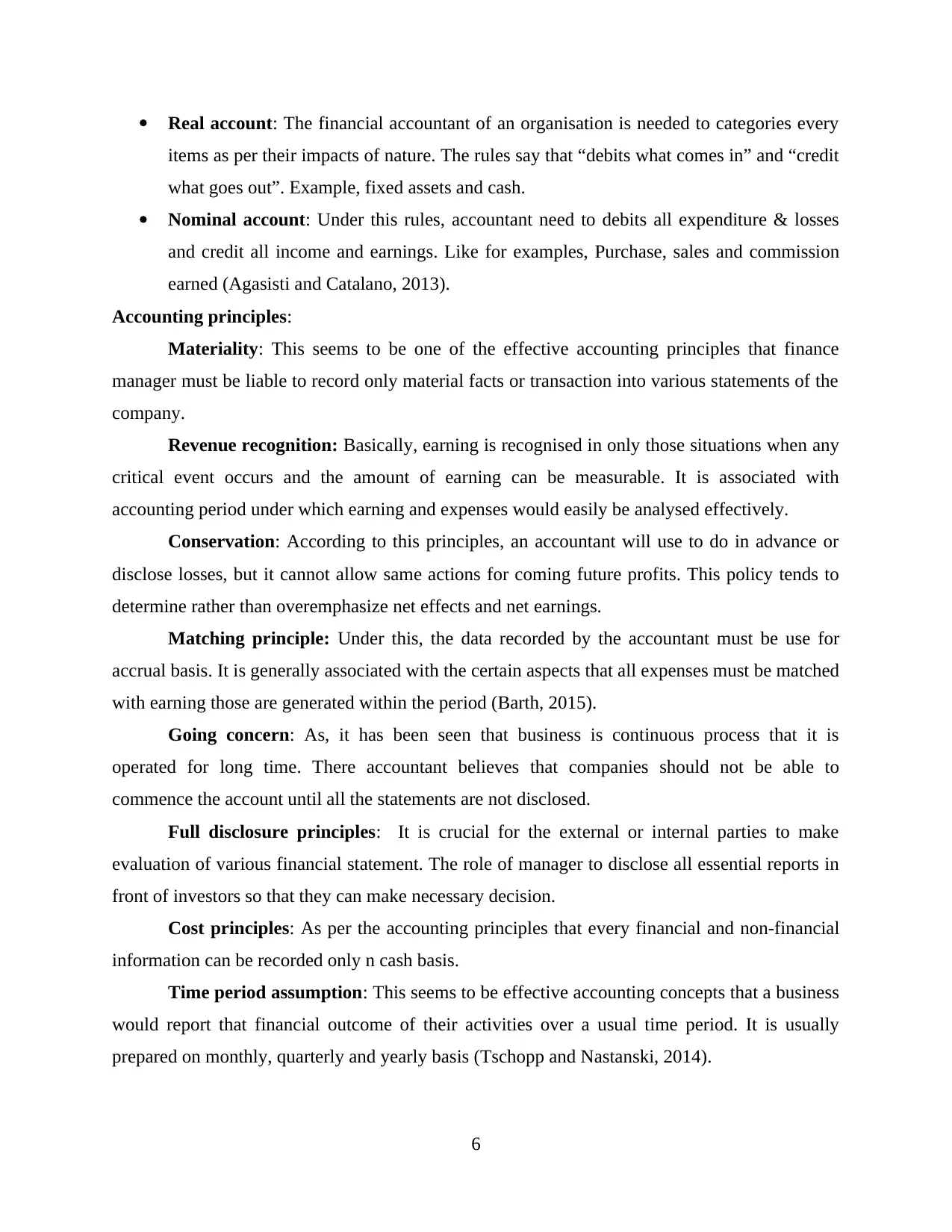
Real account: The financial accountant of an organisation is needed to categories every
items as per their impacts of nature. The rules say that “debits what comes in” and “credit
what goes out”. Example, fixed assets and cash.
Nominal account: Under this rules, accountant need to debits all expenditure & losses
and credit all income and earnings. Like for examples, Purchase, sales and commission
earned (Agasisti and Catalano, 2013).
Accounting principles:
Materiality: This seems to be one of the effective accounting principles that finance
manager must be liable to record only material facts or transaction into various statements of the
company.
Revenue recognition: Basically, earning is recognised in only those situations when any
critical event occurs and the amount of earning can be measurable. It is associated with
accounting period under which earning and expenses would easily be analysed effectively.
Conservation: According to this principles, an accountant will use to do in advance or
disclose losses, but it cannot allow same actions for coming future profits. This policy tends to
determine rather than overemphasize net effects and net earnings.
Matching principle: Under this, the data recorded by the accountant must be use for
accrual basis. It is generally associated with the certain aspects that all expenses must be matched
with earning those are generated within the period (Barth, 2015).
Going concern: As, it has been seen that business is continuous process that it is
operated for long time. There accountant believes that companies should not be able to
commence the account until all the statements are not disclosed.
Full disclosure principles: It is crucial for the external or internal parties to make
evaluation of various financial statement. The role of manager to disclose all essential reports in
front of investors so that they can make necessary decision.
Cost principles: As per the accounting principles that every financial and non-financial
information can be recorded only n cash basis.
Time period assumption: This seems to be effective accounting concepts that a business
would report that financial outcome of their activities over a usual time period. It is usually
prepared on monthly, quarterly and yearly basis (Tschopp and Nastanski, 2014).
6
items as per their impacts of nature. The rules say that “debits what comes in” and “credit
what goes out”. Example, fixed assets and cash.
Nominal account: Under this rules, accountant need to debits all expenditure & losses
and credit all income and earnings. Like for examples, Purchase, sales and commission
earned (Agasisti and Catalano, 2013).
Accounting principles:
Materiality: This seems to be one of the effective accounting principles that finance
manager must be liable to record only material facts or transaction into various statements of the
company.
Revenue recognition: Basically, earning is recognised in only those situations when any
critical event occurs and the amount of earning can be measurable. It is associated with
accounting period under which earning and expenses would easily be analysed effectively.
Conservation: According to this principles, an accountant will use to do in advance or
disclose losses, but it cannot allow same actions for coming future profits. This policy tends to
determine rather than overemphasize net effects and net earnings.
Matching principle: Under this, the data recorded by the accountant must be use for
accrual basis. It is generally associated with the certain aspects that all expenses must be matched
with earning those are generated within the period (Barth, 2015).
Going concern: As, it has been seen that business is continuous process that it is
operated for long time. There accountant believes that companies should not be able to
commence the account until all the statements are not disclosed.
Full disclosure principles: It is crucial for the external or internal parties to make
evaluation of various financial statement. The role of manager to disclose all essential reports in
front of investors so that they can make necessary decision.
Cost principles: As per the accounting principles that every financial and non-financial
information can be recorded only n cash basis.
Time period assumption: This seems to be effective accounting concepts that a business
would report that financial outcome of their activities over a usual time period. It is usually
prepared on monthly, quarterly and yearly basis (Tschopp and Nastanski, 2014).
6
⊘ This is a preview!⊘
Do you want full access?
Subscribe today to unlock all pages.

Trusted by 1+ million students worldwide
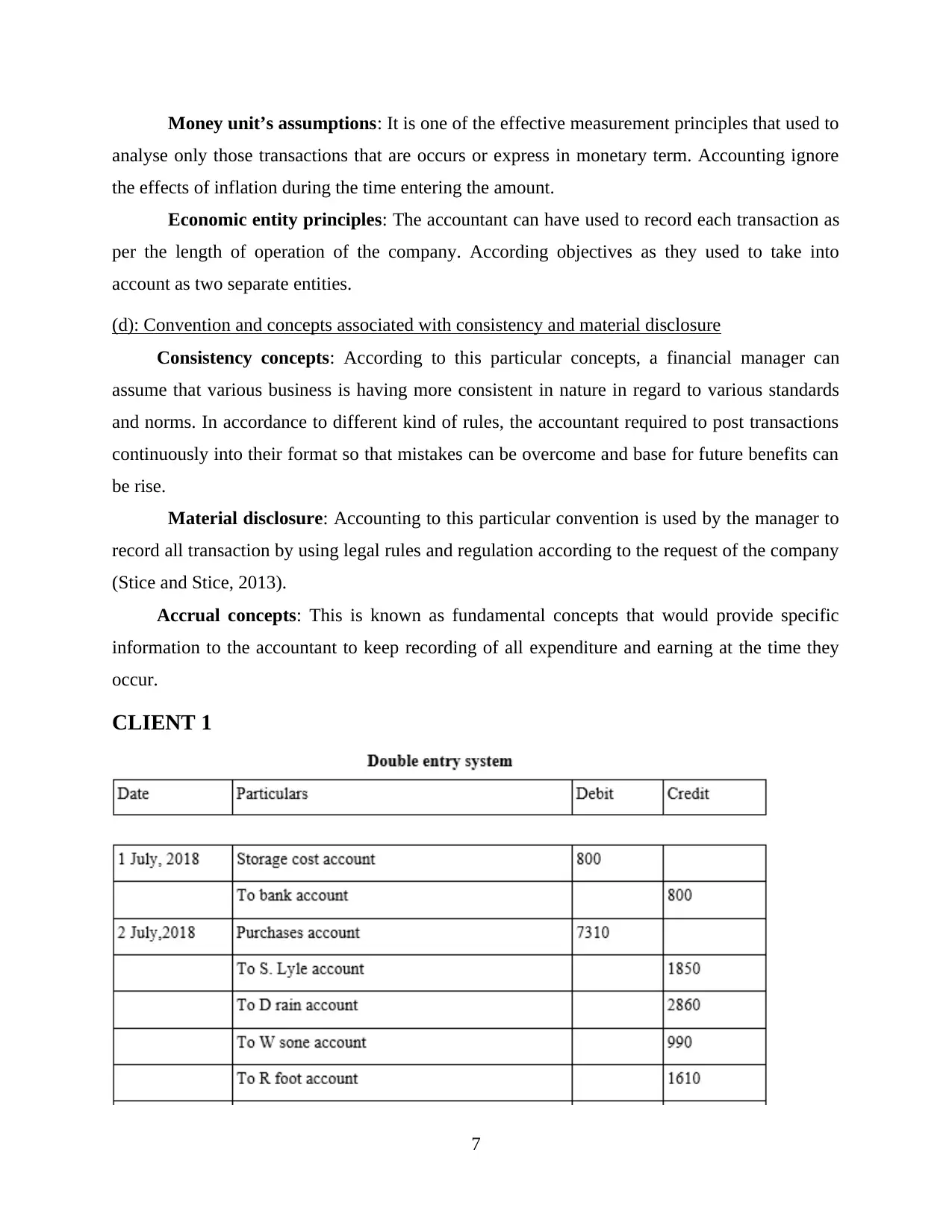
Money unit’s assumptions: It is one of the effective measurement principles that used to
analyse only those transactions that are occurs or express in monetary term. Accounting ignore
the effects of inflation during the time entering the amount.
Economic entity principles: The accountant can have used to record each transaction as
per the length of operation of the company. According objectives as they used to take into
account as two separate entities.
(d): Convention and concepts associated with consistency and material disclosure
Consistency concepts: According to this particular concepts, a financial manager can
assume that various business is having more consistent in nature in regard to various standards
and norms. In accordance to different kind of rules, the accountant required to post transactions
continuously into their format so that mistakes can be overcome and base for future benefits can
be rise.
Material disclosure: Accounting to this particular convention is used by the manager to
record all transaction by using legal rules and regulation according to the request of the company
(Stice and Stice, 2013).
Accrual concepts: This is known as fundamental concepts that would provide specific
information to the accountant to keep recording of all expenditure and earning at the time they
occur.
CLIENT 1
7
analyse only those transactions that are occurs or express in monetary term. Accounting ignore
the effects of inflation during the time entering the amount.
Economic entity principles: The accountant can have used to record each transaction as
per the length of operation of the company. According objectives as they used to take into
account as two separate entities.
(d): Convention and concepts associated with consistency and material disclosure
Consistency concepts: According to this particular concepts, a financial manager can
assume that various business is having more consistent in nature in regard to various standards
and norms. In accordance to different kind of rules, the accountant required to post transactions
continuously into their format so that mistakes can be overcome and base for future benefits can
be rise.
Material disclosure: Accounting to this particular convention is used by the manager to
record all transaction by using legal rules and regulation according to the request of the company
(Stice and Stice, 2013).
Accrual concepts: This is known as fundamental concepts that would provide specific
information to the accountant to keep recording of all expenditure and earning at the time they
occur.
CLIENT 1
7
Paraphrase This Document
Need a fresh take? Get an instant paraphrase of this document with our AI Paraphraser
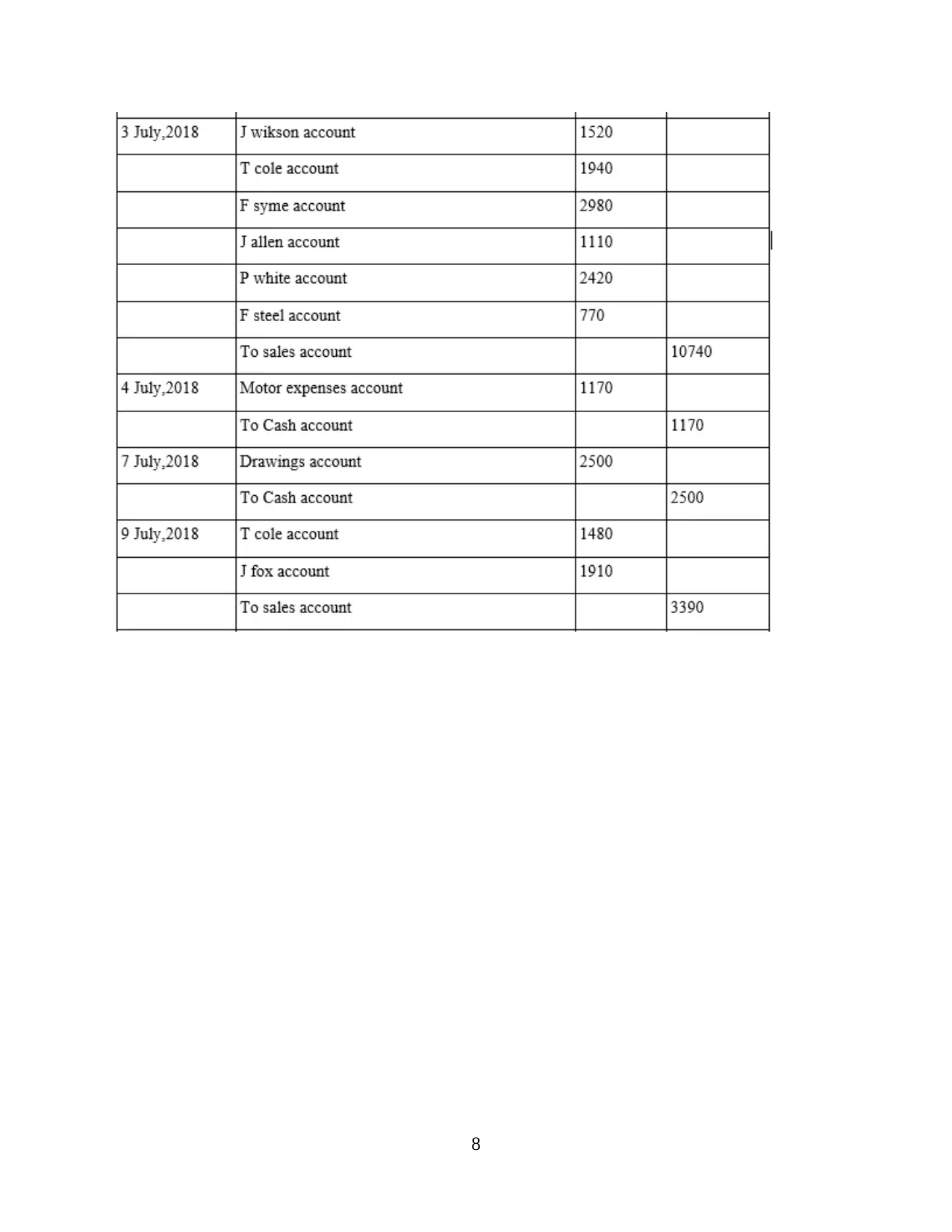
8
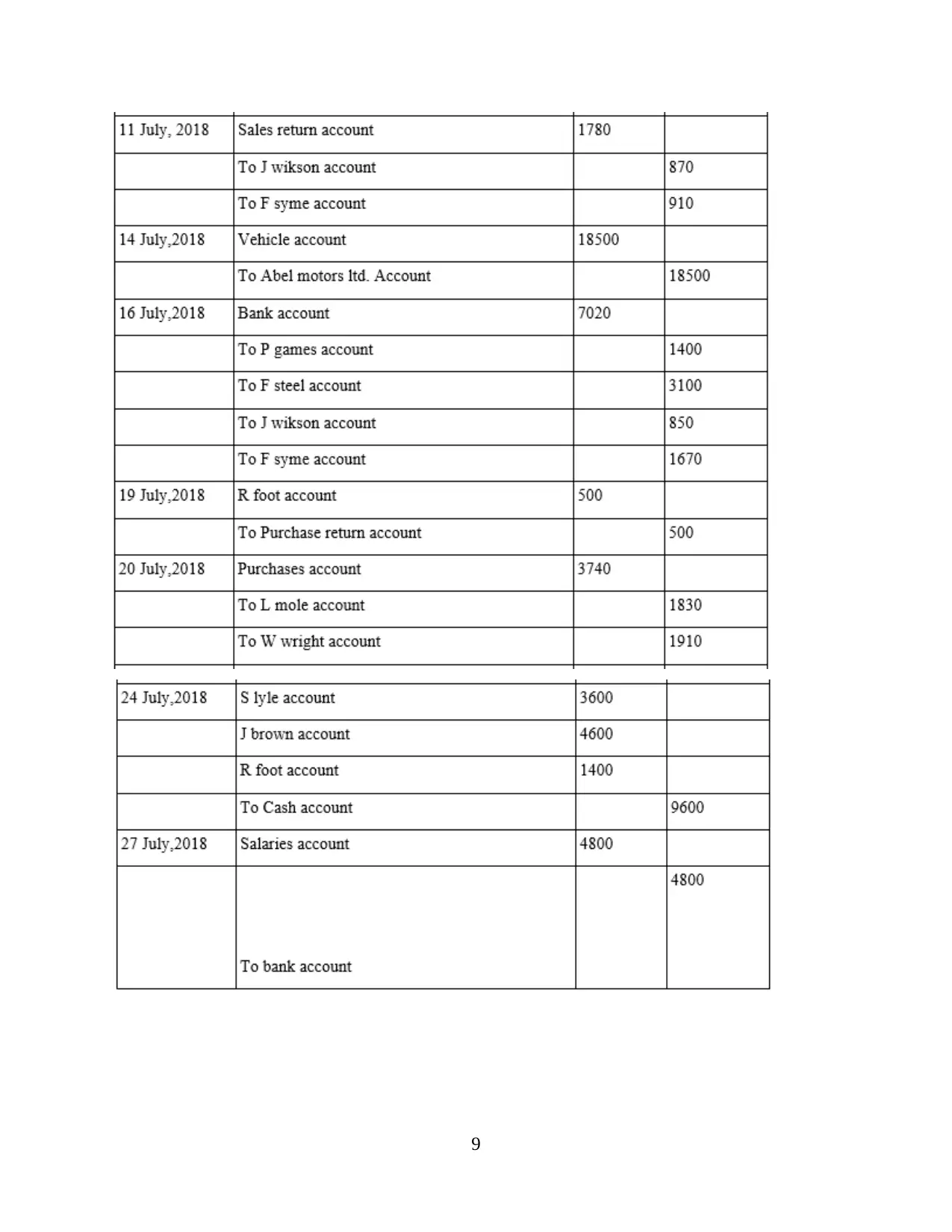
9
⊘ This is a preview!⊘
Do you want full access?
Subscribe today to unlock all pages.

Trusted by 1+ million students worldwide
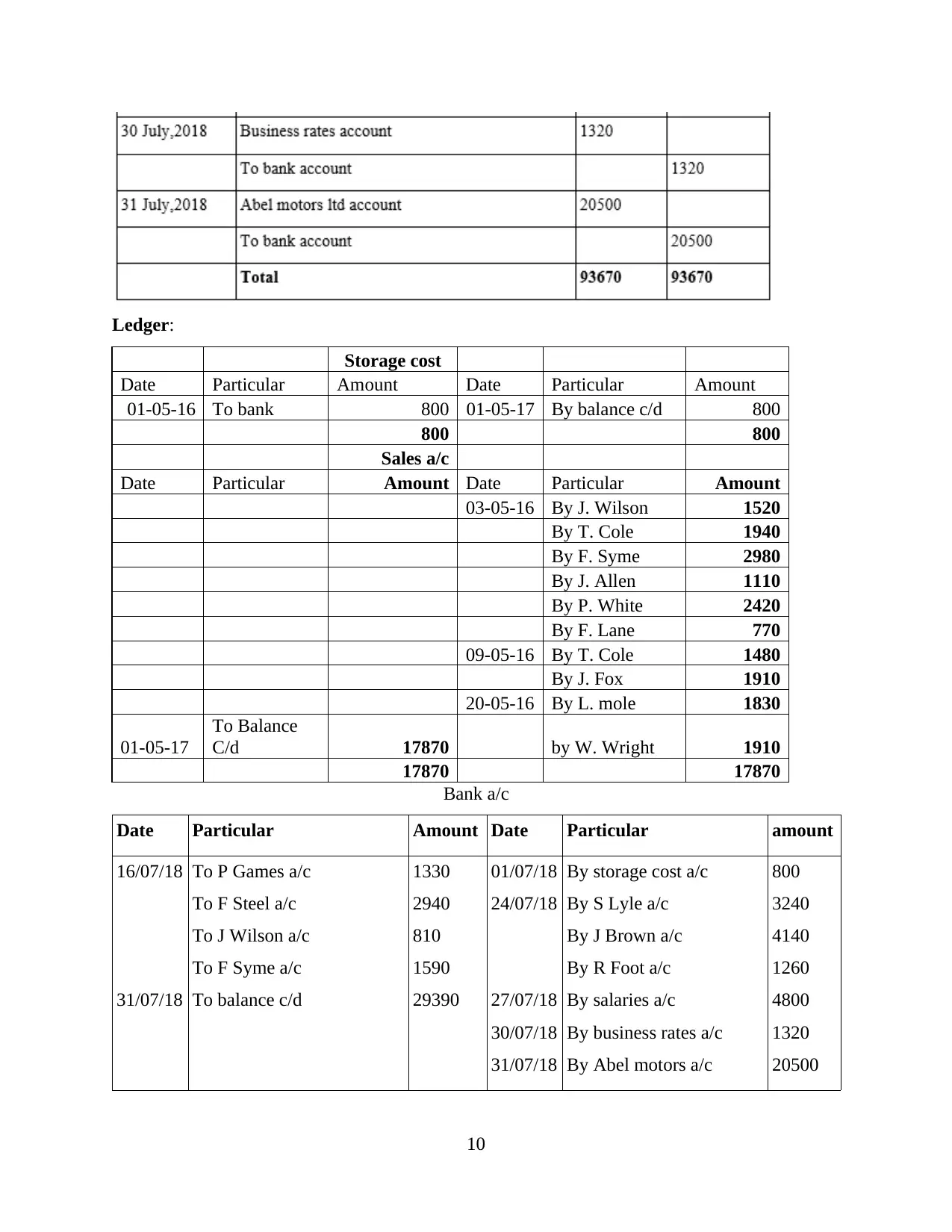
Ledger:
Storage cost
Date Particular Amount Date Particular Amount
01-05-16 To bank 800 01-05-17 By balance c/d 800
800 800
Sales a/c
Date Particular Amount Date Particular Amount
03-05-16 By J. Wilson 1520
By T. Cole 1940
By F. Syme 2980
By J. Allen 1110
By P. White 2420
By F. Lane 770
09-05-16 By T. Cole 1480
By J. Fox 1910
20-05-16 By L. mole 1830
01-05-17
To Balance
C/d 17870 by W. Wright 1910
17870 17870
Bank a/c
Date Particular Amount Date Particular amount
16/07/18
31/07/18
To P Games a/c
To F Steel a/c
To J Wilson a/c
To F Syme a/c
To balance c/d
1330
2940
810
1590
29390
01/07/18
24/07/18
27/07/18
30/07/18
31/07/18
By storage cost a/c
By S Lyle a/c
By J Brown a/c
By R Foot a/c
By salaries a/c
By business rates a/c
By Abel motors a/c
800
3240
4140
1260
4800
1320
20500
10
Storage cost
Date Particular Amount Date Particular Amount
01-05-16 To bank 800 01-05-17 By balance c/d 800
800 800
Sales a/c
Date Particular Amount Date Particular Amount
03-05-16 By J. Wilson 1520
By T. Cole 1940
By F. Syme 2980
By J. Allen 1110
By P. White 2420
By F. Lane 770
09-05-16 By T. Cole 1480
By J. Fox 1910
20-05-16 By L. mole 1830
01-05-17
To Balance
C/d 17870 by W. Wright 1910
17870 17870
Bank a/c
Date Particular Amount Date Particular amount
16/07/18
31/07/18
To P Games a/c
To F Steel a/c
To J Wilson a/c
To F Syme a/c
To balance c/d
1330
2940
810
1590
29390
01/07/18
24/07/18
27/07/18
30/07/18
31/07/18
By storage cost a/c
By S Lyle a/c
By J Brown a/c
By R Foot a/c
By salaries a/c
By business rates a/c
By Abel motors a/c
800
3240
4140
1260
4800
1320
20500
10
Paraphrase This Document
Need a fresh take? Get an instant paraphrase of this document with our AI Paraphraser
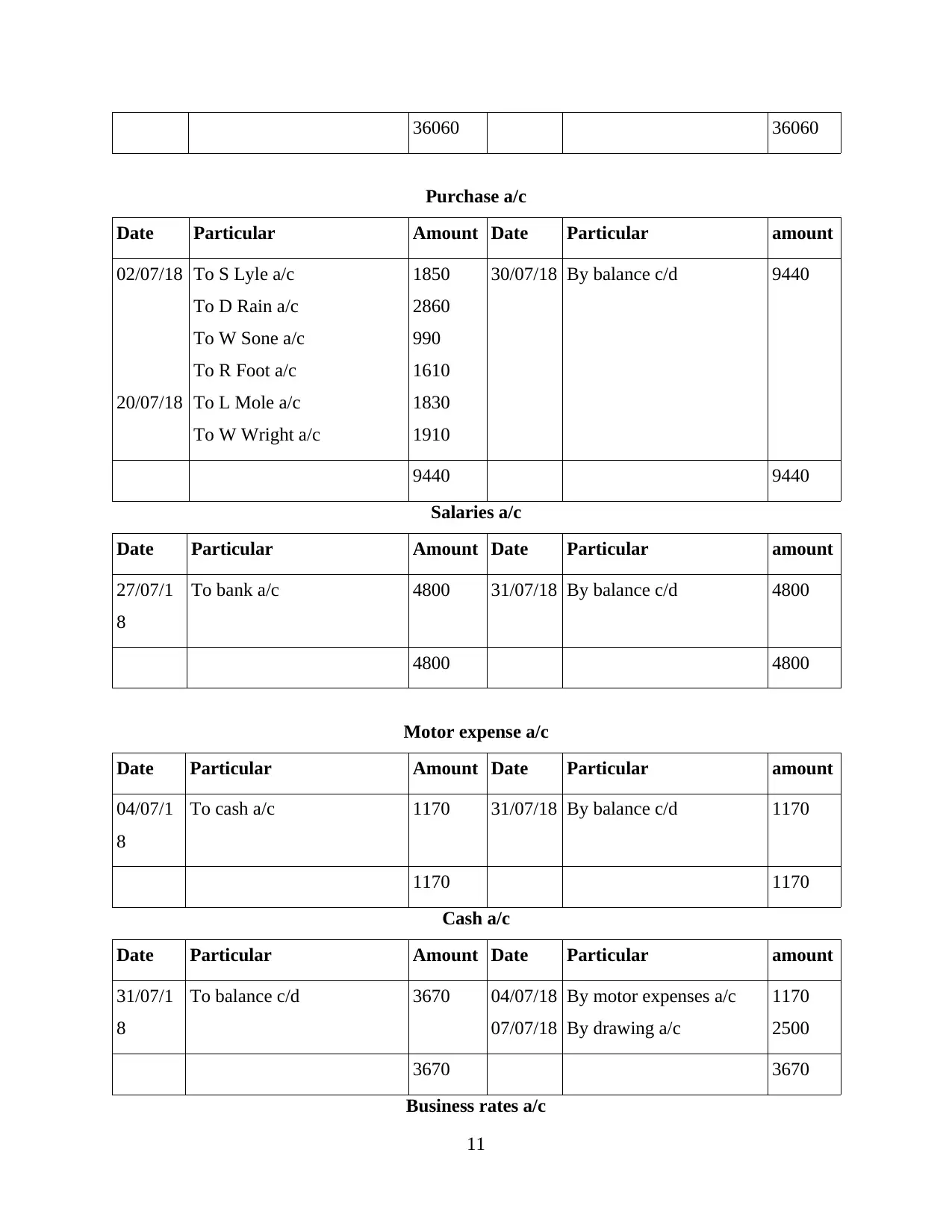
36060 36060
Purchase a/c
Date Particular Amount Date Particular amount
02/07/18
20/07/18
To S Lyle a/c
To D Rain a/c
To W Sone a/c
To R Foot a/c
To L Mole a/c
To W Wright a/c
1850
2860
990
1610
1830
1910
30/07/18 By balance c/d 9440
9440 9440
Salaries a/c
Date Particular Amount Date Particular amount
27/07/1
8
To bank a/c 4800 31/07/18 By balance c/d 4800
4800 4800
Motor expense a/c
Date Particular Amount Date Particular amount
04/07/1
8
To cash a/c 1170 31/07/18 By balance c/d 1170
1170 1170
Cash a/c
Date Particular Amount Date Particular amount
31/07/1
8
To balance c/d 3670 04/07/18
07/07/18
By motor expenses a/c
By drawing a/c
1170
2500
3670 3670
Business rates a/c
11
Purchase a/c
Date Particular Amount Date Particular amount
02/07/18
20/07/18
To S Lyle a/c
To D Rain a/c
To W Sone a/c
To R Foot a/c
To L Mole a/c
To W Wright a/c
1850
2860
990
1610
1830
1910
30/07/18 By balance c/d 9440
9440 9440
Salaries a/c
Date Particular Amount Date Particular amount
27/07/1
8
To bank a/c 4800 31/07/18 By balance c/d 4800
4800 4800
Motor expense a/c
Date Particular Amount Date Particular amount
04/07/1
8
To cash a/c 1170 31/07/18 By balance c/d 1170
1170 1170
Cash a/c
Date Particular Amount Date Particular amount
31/07/1
8
To balance c/d 3670 04/07/18
07/07/18
By motor expenses a/c
By drawing a/c
1170
2500
3670 3670
Business rates a/c
11
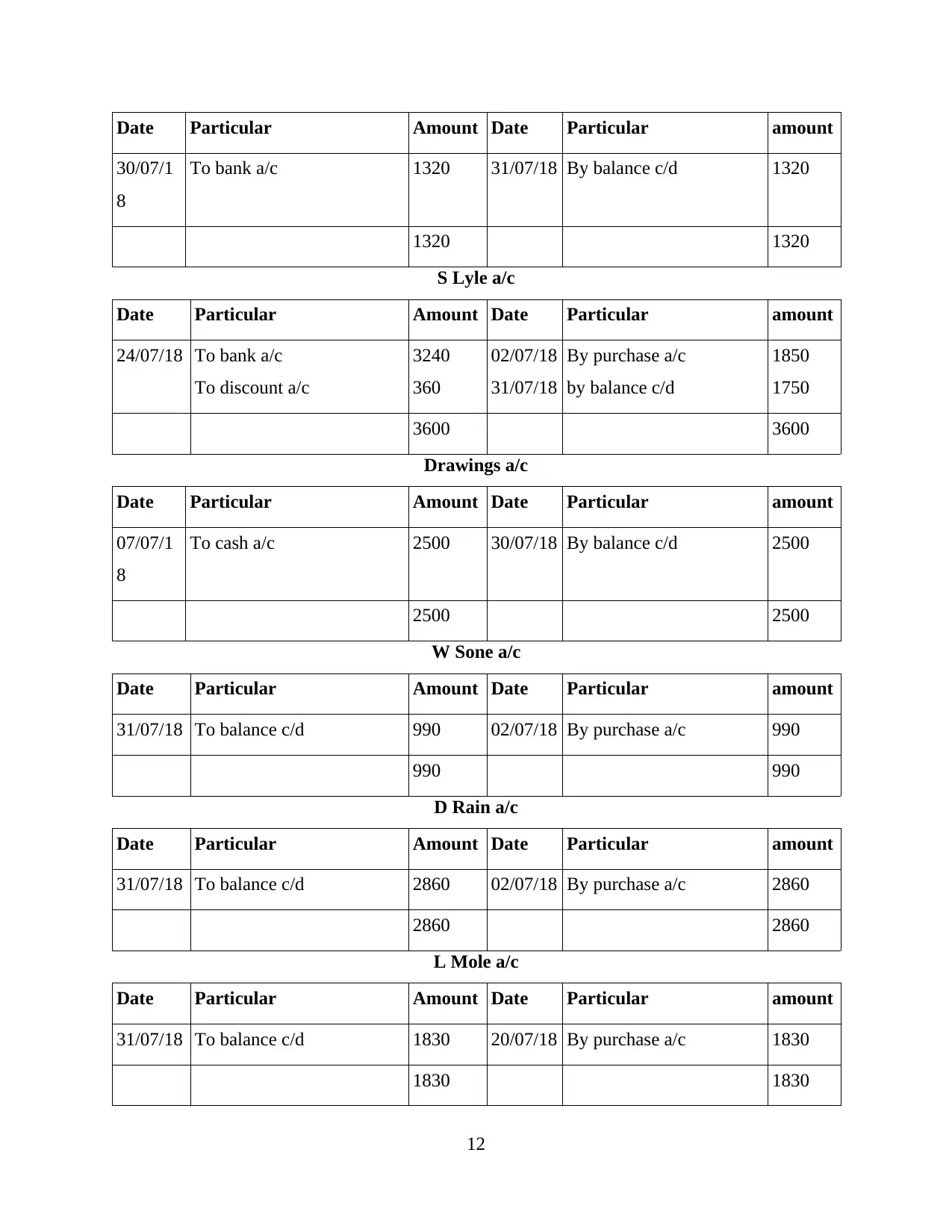
Date Particular Amount Date Particular amount
30/07/1
8
To bank a/c 1320 31/07/18 By balance c/d 1320
1320 1320
S Lyle a/c
Date Particular Amount Date Particular amount
24/07/18 To bank a/c
To discount a/c
3240
360
02/07/18
31/07/18
By purchase a/c
by balance c/d
1850
1750
3600 3600
Drawings a/c
Date Particular Amount Date Particular amount
07/07/1
8
To cash a/c 2500 30/07/18 By balance c/d 2500
2500 2500
W Sone a/c
Date Particular Amount Date Particular amount
31/07/18 To balance c/d 990 02/07/18 By purchase a/c 990
990 990
D Rain a/c
Date Particular Amount Date Particular amount
31/07/18 To balance c/d 2860 02/07/18 By purchase a/c 2860
2860 2860
L Mole a/c
Date Particular Amount Date Particular amount
31/07/18 To balance c/d 1830 20/07/18 By purchase a/c 1830
1830 1830
12
30/07/1
8
To bank a/c 1320 31/07/18 By balance c/d 1320
1320 1320
S Lyle a/c
Date Particular Amount Date Particular amount
24/07/18 To bank a/c
To discount a/c
3240
360
02/07/18
31/07/18
By purchase a/c
by balance c/d
1850
1750
3600 3600
Drawings a/c
Date Particular Amount Date Particular amount
07/07/1
8
To cash a/c 2500 30/07/18 By balance c/d 2500
2500 2500
W Sone a/c
Date Particular Amount Date Particular amount
31/07/18 To balance c/d 990 02/07/18 By purchase a/c 990
990 990
D Rain a/c
Date Particular Amount Date Particular amount
31/07/18 To balance c/d 2860 02/07/18 By purchase a/c 2860
2860 2860
L Mole a/c
Date Particular Amount Date Particular amount
31/07/18 To balance c/d 1830 20/07/18 By purchase a/c 1830
1830 1830
12
⊘ This is a preview!⊘
Do you want full access?
Subscribe today to unlock all pages.

Trusted by 1+ million students worldwide
1 out of 27
Related Documents
Your All-in-One AI-Powered Toolkit for Academic Success.
+13062052269
info@desklib.com
Available 24*7 on WhatsApp / Email
![[object Object]](/_next/static/media/star-bottom.7253800d.svg)
Unlock your academic potential
Copyright © 2020–2025 A2Z Services. All Rights Reserved. Developed and managed by ZUCOL.




